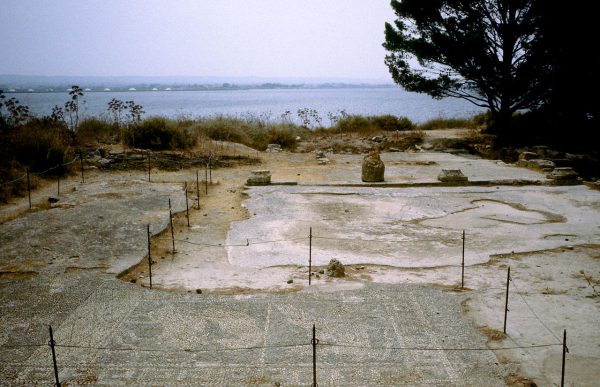The House of Mosaics (Mozia)
Area belonging to the archaeological site of Mozia
Along the south-eastern coast of the island there is a partially excavated building complex, called the “House of the mosaics”, built on two levels on the slope that slopes down towards the sea. The eastern limit is visible and the south-east corner is against the fortification wall of the city. The north and east part consisted of a large rectangular peristyle courtyard, surrounded by some residential areas, while the south-western part was a service area. The floor of the peristyle was decorated with a mosaic of black, white and gray pebbles of which a short section is preserved in the north-east corner, with panels, depicting animals (a lion attacking a bull, a griffin attacking a cervid, and a lion and a cervid on two panels), separated by a diamond pattern and delimited by a tripartite border (bands with meander, lotus flowers and palmettes, wave pattern).
A small room at the southwestern end of the court had a checkerboard floor of earthenware and flakes of white stone. The rooms to the east, only the floors. In the southern area there was a small structure interpreted as a small oven. The service area is divided into six rooms, perhaps partly obtained in a pre-existing building, with stone walls and recycled materials. The room communicating with the court featured a well dug into the ground and was subsequently also occupied by a hearth. Along the west side runs a channel that led the rainwater collected in the courtyard outside the building, exploiting the downward slope of the land. An area used as a warehouse preserves the remains of three great ones pithoiIn another room, five Doric and one Corinthian capitals were found, apparently stored, belonging to at least two different phases of the peristyle. while other architectural elements were also present in the area. The building had to undergo some alterations and was probably the subject of looting. The dating of the building and the mosaic floor is disputed: the absence of internal details of the figures and the partitioning of the panels with rhombus with white lines on a black background, find comparisons in the third century BC (Eretria, Olbia, Tarsus).
Source: wikipedia, web
Photo: By No Automatically Readable Author. wikipedia
Card insertion: Ignazio Caloggero
Information contributions: Web, Region of Sicily
Note: The populating of the files of the Heritage database proceeds in incremental phases: cataloging, georeferencing, insertion of information and images. The cultural property in question has been cataloged, georeferenced and the first information entered. In order to enrich the information content, further contributions are welcome, if you wish you can contribute through our area "Your Contributions"



